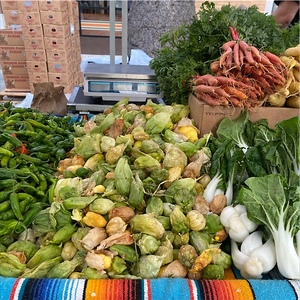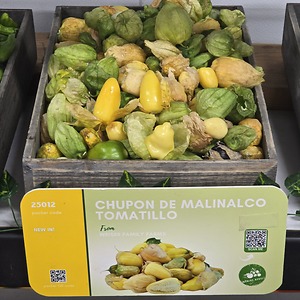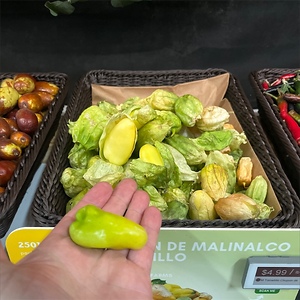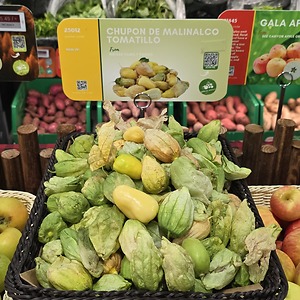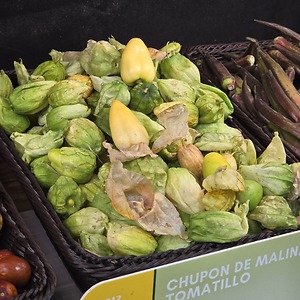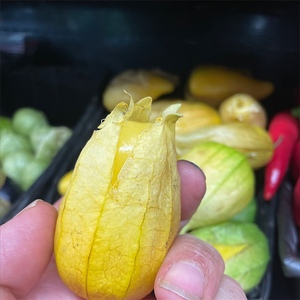


Chupon de Malinalco Tomatillos
Estimated Inventory, lb : 0
This item was last sold on : 01/16/25
Description/Taste
Chupon de Malinalco tomatillos are a lemon-colored vegetable that measures about 10 centimeters long. They have a conical, slight heart shape with a rounded tip and transition from green to bright yellow as they mature. Their thick skin is shiny and smooth, covered in light brown-yellow papery husks that may possess faint shades of green, particularly at the top of the husks. Chupon de Malinalco tomatillos have thin, light green stems, and when sliced in half lengthwise reveal a light yellow, semi-transparent interior with small seed cavities surrounded by thick, pulpy flesh. This flesh is tender, smooth, and juicy with tiny, edible seeds dispersed throughout the inside of the vegetable. Chupon de Malinalco tomatillos have a sweet-tart flavor with fruity, tropical notes.
Seasons/Availability
Chupon de Malinalco tomatillos are available from summer to mid-fall.
Current Facts
Chupon de Malinalco tomatillos are botanically known as Physalis ixocarpa and belong to the Solanaceae family, which also includes potatoes, chili peppers, eggplants, tomatoes, and bell peppers. This variety originates from the Southern Mexican town of Malinalco in the Ixtapan region, which is also home to a similar looking tomatillo called the Reina de Malinalco. Tomatillos are technically a fruit but in culinary use, are treated and referred to as vegetables. Their name translates to little tomato in Spanish and they are often referred to as husk tomatoes, even though tomatillos are not technically part of the tomato family. Other common names for this vegetable are Chinese lanterns, Ground cherries, Tomate Milpero, and Tomate de Cascara. Chupon de Malinalco tomatillos are prized for their culinary value in Mexican cuisine, especially in sauces like salsa verde and mole.
Nutritional Value
The nutritional value of Chupon de Malinalco tomatillos isn’t widely known, but the tomatillo species is generally high in dietary fiber that supports digestive health by promoting regular bowel movements, satiety, and gut health. This vegetable's vitamin C content plays a crucial role in boosting the immune system, promoting collagen production for healthy skin, and acting as a powerful antioxidant that protects against free radical damage. Tomatillo's vitamin K is essential for bone health as it helps with calcium absorption and blood clotting. The niacin in tomatillos supports metabolic processes and is vital for converting food into energy, while also aiding in maintaining healthy cholesterol levels. This vegetable possesses the carotenoids zeaxanthin and lutein, which are important for eye health because they protect against harmful blue light and reduce the risk of age-related macular degeneration.
Applications
Chupon de Malinalco tomatillos are best enjoyed raw but can also be dried, cooked, grilled, or preserved in jams and chutneys. The convenient small size of these vegetables makes them easy to eat fresh out of hand. They can also be chopped into salads, salsas, tacos, and guacamole. Chupon de Malinalco tomatillos may be incorporated into enchiladas, grilled kabobs, burritos, curries, dals, and soups like gazpacho. This variety pairs well with grilled meats and seafood dishes and can also be stuffed like a mini pepper with ingredients like cream cheese, rice, pork, zucchini, black beans, cilantro, and chili powder. Chupon de Malinalco tomatillos pair well with cumin, garlic, onions, chickpeas, lime, shredded chicken, ground beef, quinoa, couscous, goat cheese, ricotta, chives, walnuts, almonds, sunflower seeds, pineapple, and mango. These vegetables should be harvested at peak ripeness when their skins burst. They can be refrigerated in a paper bag with their husks on for 2 to 3 weeks.
Ethnic/Cultural Info
Tomatillos are an important vegetable in Mexican and Central American cuisines, where they are featured in dishes such as mole and salsa verde. The Aztecs are believed to be the first people to have domesticated tomatillos. One of the earliest references to salsa is documented in Bernardino de Sahagún's 16th-century text, the Florentine Codex. This is a manuscript that documents the history and culture of Aztec civilizations before and after Spanish colonists arrived in Mexico. Sahagún was a Spanish Franciscan missionary and scholar who wrote the Florentine Codex in both Spanish and Nahuatl, the native language of the Aztecs. This text describes early salsa recipes to have included tomatillos, tomatoes, squash seeds, and beans.
Geography/History
Chupon de Malinalco tomatillos are native to Malinalco, Mexico. They thrive in climates with full sun exposure. The tomatillo species originated in Mexico around 800 BCE and was consumed by both the Aztecs and Mayans. When Spanish colonists arrived in Mexico and Central America during the 16th and 17th centuries, they brought tomatillos back with them to Spain. By the mid-20th century, this vegetable was introduced to East Africa and to India, where it has been incorporated into many traditional dishes. Chupon de Malinalco tomatillos are primarily cultivated in commercial and home garden settings rather than being found in the wild. They are popular in their native city of Malinalco, Mexico, where they are often sold in street markets. Outside of Mexico, Chupon de Malinalco tomatillos are most commonly found in stores that specialize in Latin cuisine or are grown from seeds in gardens.



